STORY BY BENJAMIN LERNER
PHOTOGRAPHY JIMMY iENNER, Jr.
Vermont Rocks creates inventive and beautiful home décor pieces using locally-sourced stones.
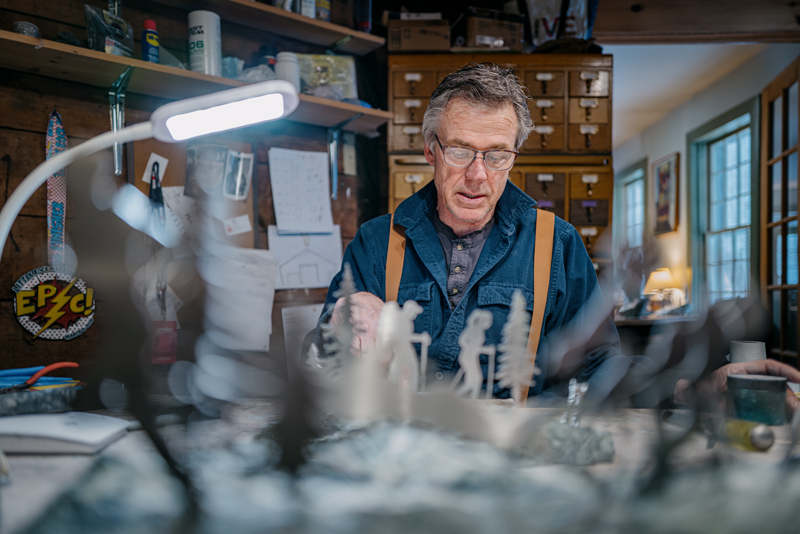
On a quiet country road in Newfane, Vermont, a charming house and barn overlook a gorgeous, winding brook. While the stones lining the river’s banks may seem like ordinary rocks to the untrained observer, one would be unwise to disregard their value. To John Davis, the rocks are priceless treasures waiting to be shaped and molded into beautiful works of art. Born and raised in Newfane, John Davis is the founder and chief artist at Vermont Rocks. Over the past several years, John has built a thriving independent business with his wife and business partner, Terry Davis. Drawing on his years of lived experience as an endurance athlete, John builds unique sculptures that accurately depict the dynamic motions of hikers, swimmers, skiers, and bikers. By creating pieces that cater directly to the visual sensibilities of outdoor sports enthusiasts, John and Terry have managed to carve a unique and lasting niche in Vermont’s artisan craft market. Their core values of hard work and honesty are manifested through their beautiful and timeless products, and their dedication to quality customer service runs even deeper than the waters and quarries that hold Vermont’s most breathtaking stones.
How the Sculptures Are Made
Every sculpture created at the Vermont Rocks studio in Newfane is fashioned out of two components: a Vermont-sourced rock, which serves as the base of the sculpture, and laser-carved metal figures that are affixed to the surface of the stone. The process begins with John selecting a rock to use in the sculpture. All of the rocks that he uses are either sustainably sourced from the nearby riverbeds or purchased from a serpentine or marble quarry in Vermont. John looks for different qualities in the rocks that he uses depending on the nature of the sculpture. If a sculpture features a kayaker paddling down a stream, John will opt for a piece of brilliant green Vermont serpentine stone with a fluid and curved shape. For “Western” sculptures that feature American Southwestern imagery, he will likely choose a dark-toned “river rock” that suits the desert-themed aesthetic of the piece. If he is creating a sculpture that features a skier or snowboarder, he will use a nice piece of Vermont marble with a noticeable slope. “The stone should ideally lend itself to creating a sense of natural motion,” says John. “It has to look right and it has to look natural.”
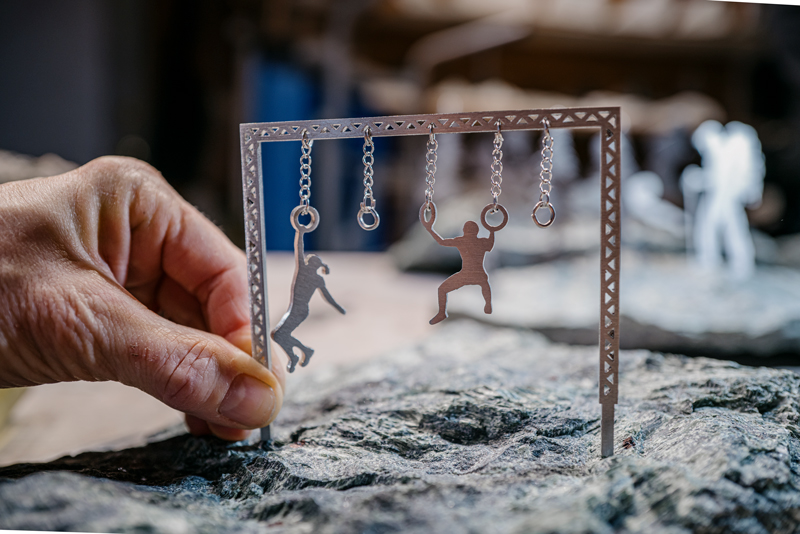
After selecting the rock, John takes it to his work area, which is equipped with a wet tile saw. Once there, John turns on a hose that feeds water into the area of the tool where the blade meets the stone. This reduces friction and extends the life of the blade. He then uses the wet tile saw to cut the stone until its base is flat. John says that the piece has to be level and secure so that it can be displayed prominently on any surface. John adds that occasionally, a rock will be too big to slide through the saw without additional cuts. “Sometimes I have to do a series of dangerous gyrations with the rocks to get it to work. I’ve learned to do it in a way that allows me to do it somewhat safely, but I nevertheless have to exercise extreme caution.”
When the initial large cuts have been made, John begins grinding down the rock into an ideal shape. In order to accomplish this, he uses a tool known as an angle grinder. He then polishes the rock with a wet polisher, which smooths the rock by grinding it down even further with polishing pads. Once a rock is smoothed and polished, John brings it to a table inside his studio. He checks its flatness to make sure it’s not teetering and adds felt pads underneath the stone. Afterwards, he begins the nuanced and exacting process of placing the metal figures on the stone. “The angle is incredibly important when you’re placing a figure,” says John. “If I’m placing a mountain biker figure on a sloped rock, it has to be placed at a legitimate angle that a mountain biker would attempt. If I’m placing a hiking figure on a rock, their foot placement has to look natural. I experiment with different placements by holding the figures over the surface of the stone. When I find the right spot, I mark it with a little dot.”
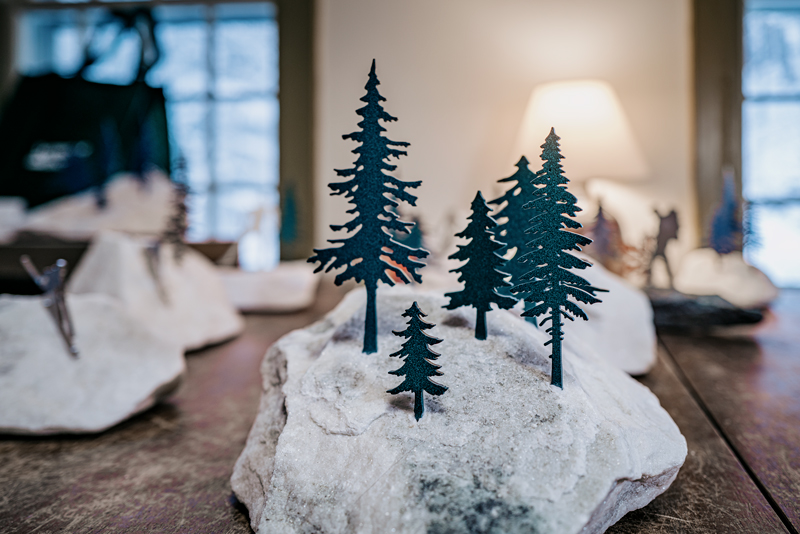
After deciding the placement of the figures, John drills a hole in the surface of the rock, then glues the figures into the hole with a proprietary epoxy adhesive. In order to give the sculptures a seamless appearance, he mixes the dust that he collects when he drills the holes in with the epoxy adhesive. Vermont Rocks’ sculptures come in all sizes, and feature a variety of different figures, such as athletes, snowmobiles, animals, maple leaves, mythological characters, and trees.
All of the metal figures used in the sculptures are fabricated by Allied Steel Fabricators. John works closely with their graphic design team to create figures that possess a tangible sense of dynamic motion. “I don’t feel right about selling sculptures with figures that seem stiff or unnatural,” says John. “I spend a lot of time working with Allied Steel to tweak our designs to the point that they work.”
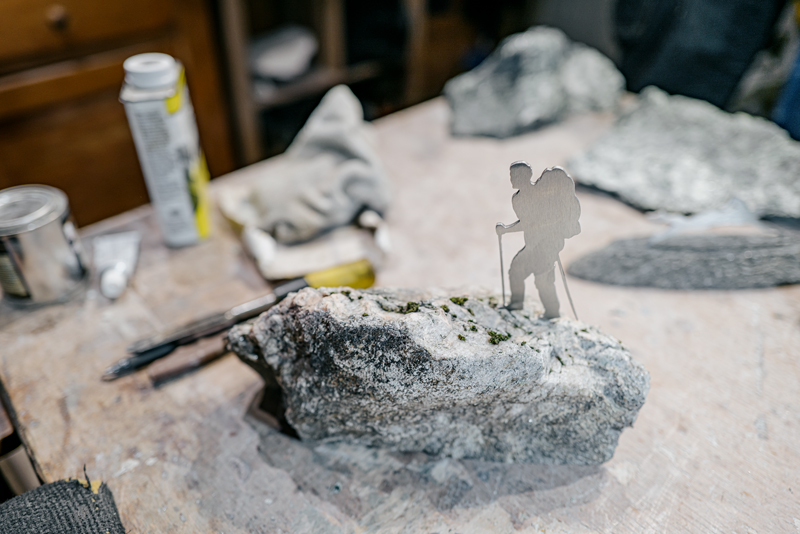
According to John, all of the copper and steel figures that he uses in his sculptures are cut out of large pieces of sheet metal by a machine that uses a computerized laser. Although the vast majority of the figures that John uses in his sculptures are made with stainless steel, he also likes to use copper trees in his sculptures. John elaborates: “The tree figures are a beautiful and simple option for people that don’t want sports figures or wildlife figures on their sculptures. We offer many sculptures that use both steel and copper tree figures. When copper is cut with a laser, it makes a beautiful burn patina pattern. We also occasionally treat the copper trees with ammonia, salt, and other household chemicals here in our studio to give them a stunning green color.”
Recently, John has also started working with Allied Steel Fabricators to produce a series of powder-coated steel figures. The figures are available in black and red official IRONMAN colors, as well as a retro-chic extreme sports color scheme, an autumnal orange and yellow color scheme, and a purple and blue “Galaxy” color scheme.
Although the majority of Vermont Rocks’ pieces are pre-made, John and Terry are happy to work with customers directly to bring their vision to life. When John is
making custom-ordered sculptures, he and Terry will work together to effectively meet the needs of their customers. “We want to make sure that we communicate with our customers throughout the entire process,” says John. “In order to make sure they like where the figures are placed on the rock, I will hold the figures down on the stone while Terry takes a picture of them. We will then attach the pictures to an email and send it to our customers for feedback. We’ll also send the dimensions and weight of the stone to our customers to make sure it works with the space that they have in mind.” John says that although the process can be time-consuming, it’s important to ensure that the piece is exactly what the customer wants. “I stand behind my work. If I don’t love it or the customer doesn’t love it, I don’t send it out.”
The Story Behind the Stones
From the earliest days of his childhood in Southern Vermont, John was always a passionate athlete and a natural craftsman. “I didn’t have any strong artistic inclinations when I was growing up,” says John. “I did always like building things, though.” As a young man, John built ski pole holders for visiting ski tourists, as well as handmade leather belts and wristbands. While attending Leland & Gray Union Middle School & High School in Townshend, Vermont, John was an active participant in their athletic programs. In addition to playing on their soccer and baseball teams, he was also an avid cross country and alpine skier. John remembers spending afternoons at Stratton with great fondness. “We would take the bus to Stratton every Monday. Upper Spruce was always my favorite trail.”
After transferring from Leland & Gray Union High School to Philips Exeter Academy in Exeter, New Hampshire, John graduated from high school and went on to study at University of Vermont and University of Massachusetts Amherst. In his late teens and early twenties, John continued to hone his handiwork skills by painting houses and working on construction sites. John then graduated from UMass Amherst with an undergraduate degree in English. Upon graduating, he pursued a graduate degree in Education at Harding University in Searcy, Arkansas. John spent the next several decades moving back and forth between Arkansas, Massachusetts, and Vermont. While in Arkansas, he taught English in various different rural school districts, and he also taught at Arkansas State University. John and Terry began dating in Arkansas in 2005, and the two of them have been together ever since.
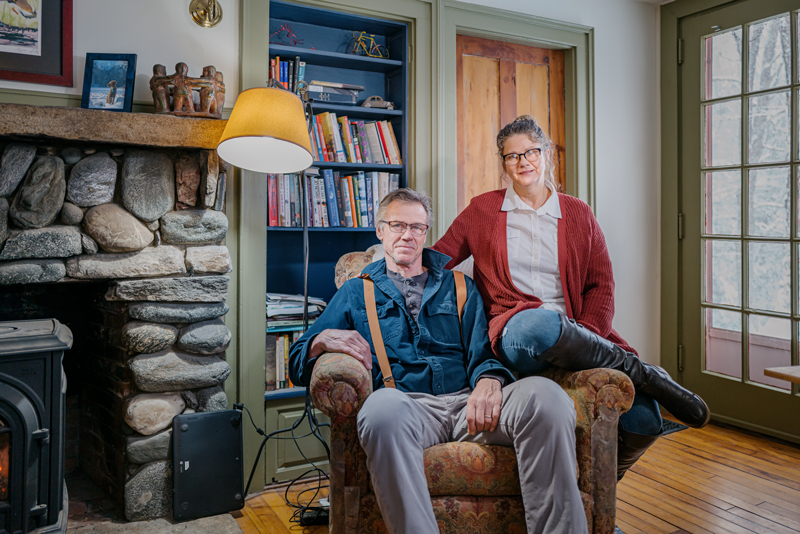
Over the course of his educational career, John became actively involved in the endurance sports community. He participated in thirteen marathons, numerous IRONMAN races, and dozens of adventure races. “Adventure races are usually 24-hour events that involve hiking through the woods, mountain biking, and kayaking,” explains John. “I’ve done about 50 adventure races around the country, so it’s been a big part of my life.” During his years on the IRONMAN and ad- venture race circuit, John traveled around the country extensively. In 2011, he and his sons organized a series of 5-kilometer “Do Life” races in order to raise awareness about health issues. “I traveled around the country running unofficial 5K races with my two sons. One of my sons struggles with obesity. Another has Crohn’s disease. We went from town to town with the sole purpose of trying to help people get healthy while forming a positive athletic community. One of my sons went from being morbidly obese to losing over a hundred pounds and appearing on the cover of Runner’s World magazine. It was a wonderful journey.”
Over the course of his travels, the idea of building and marketing something new and unique to the athletic community evolved. “I had a vague notion that I could mount something on stone and it would look cool,” says John. “It started with a tiny caricature of a runner. When we were doing the ‘Do Life’ races, we would sell t-shirts with a stick figure runner on them. I started putting a 3-dimensional metallic figurine of the caricature on stones and selling those, as well. The proceeds from the t-shirts and the stone-mounted figurines ended up paying our way across the country several times. I didn’t think I’d ever be able to make an avocation of it, much less a full-time vocation, but it was enough to keep me going.”
In the years that followed, John began experimenting with different types of mounted figurines on bigger rocks. “I started putting mountain bikers and road bikers on the rocks,” says John. “The more I did, the more ideas I had.” In 2016, John moved back up to Vermont from Arkansas. Once there, he began working as the Associate Principal at Black River Middle and High School in Ludlow. After arriving in Vermont, he started experimenting with figurines that depicted school sports, such as baseball and football. Terry soon joined him in Vermont, where she found work as a Paraeducator for nonverbal autistic children in Putney. “As a child, I always thought I would move somewhere that was beautiful and mountainous,” says Terry. “It just so happened that I ended up meeting a wonderful man from Vermont, so I did get to move to a place that was every bit as gorgeous as I had hoped.”
After John and Terry had comfortably settled in Southern Vermont, John started producing rocks with hikers, skiers and mountain biker figurines on them. These initial prototypes ultimately developed into Vermont Rocks’ most popular line of pieces. In 2016, John made his first foray into the Southern Vermont arts scene when he set up a booth at a craft fair at the Black River Middle and High School in Ludlow. Although his first professional outing was not nearly as smooth as the polished surfaces of his rock sculptures, he still learned a lot from the experience. “I had no idea what I was doing,” says John. “I just loaded up all of the pieces I had and put them on a table. Once I got there, several people noticed that I needed help. They selflessly came up to me and helped me improve my display. They showed me how to arrange and stack pieces on different levels to make it look nice. I ended up selling quite a few pieces, and I decided that I wanted to attend other craft fairs in other places.”
As John’s artistic aspirations continued to take shape, he reached out to a talented designer and metalsmith named Steven Manning for advice. “Steven is the owner of Silver Spoons at The Depot Gallery in Ludlow. He’s a wonderful craftsperson, and he was a truly helpful mentor for Terry and me.” John started selling his products out of Manning’s store, and eventually asked Manning if he knew about any additional regional craft fairs. For the next several years, Manning shared a list of dozens of craft fairs in Vermont, Maine, New Hampshire, Massachusetts, and Connecti- cut with John and Terry. “We would do at least one or two craft fairs per month” “every year from April to October,” says John. “We would stack our tables and shelves on top of our car, and fill the car with rocks. Our rock sculptures were a big success, and the business continued to grow from there.”
John and Terry were subsequently able to forge connections with Vermont-based suppliers of serpentine and marble rocks. In the summer of 2018, they also made a crucial connection with a woman who invited them to set up a booth at the Maine Cancer Foundation’s Tri for a Cure® triathlon race. “We ended up doing really good business at that event, and we realized that triathlon races were a fantastic market,” says John. In 2018 and 2019, John and Terry established a strong foothold at triathlon events in New York and Northern New England. When the Adirondack Trading Company in Lake Placid began carrying their sculptures, it was a watershed moment for their business. “Lake Placid is home to one of the largest IRONMAN events in North America,” says John. “It meant a lot to us that a popular store in Lake Placid with strong ties to the IRONMAN community had chosen to carry our products. They’ve remained loyal customers ever since.”
At the onset of the COVID-19 pandemic in 2020, John retired from his career in education after the Black River Middle and High School closed its doors. He and
Terry then began working full-time to build Vermont Rocks as a business. While John crafted the sculptures, Terry handled the accounting, social media, and marketing aspects of the operation. Thanks to a persistent and targeted online marketing campaign, John and Terry were able to find considerable success through online sales platforms (such as Etsy) during the early days of the pandemic. Their products are also now available in many stores in Vermont, Maryland, Wisconsin, Connecticut, Massachusetts and Colorado. In Vermont, their sculptures are sold at The Stratton Parsonage in Stratton, Persephanie in Brattleboro, The Depot Gallery in Ludlow, Vermont Eclectic Company in Woodstock, The Vermont Spot in Quechee, The Rochester Café in Rochester (Vermont), and The Body Lounge in Stowe. “Our sculptures are
perfect gifts,” says John. “They’re a great decorative addition for any home, and we have different models that are perfectly suited for customers of all tastes and preferences.”
As they look towards the future, John and Terry are looking forward to completing the renovation of their barn. “Our vision is to create a space that serves both as
a studio workshop and a retail outlet for our sculptures and other Vermont artisan products,” says Terry. “For the past several years, we’ve made gift baskets for our customers that feature different products from other small businesses in Vermont. We’re always looking to partner with new local businesses to make the baskets even better, and we’re grateful to be part of the thriving Vermont business community.” John and Terry are also excited to be hitting the road again this summer in their” “custom trailer, which is emblazoned with Vermont Rocks’ official company tagline: “Nothing says TRIATHLETE like stone and steel.” They will be bringing their sculptures to numerous outdoor athletic events, including the Obstacle Course Racing (OCR) World Championships at Stratton in September, and the New England Mountain Bike Association’s NEMBAfest in Carrabassett, Maine in August.
“We’re making some custom pieces for the OCR Championships at Stratton,” says John. “The sculptures will feature different obstacles. It’s a fun way to tie in the event and make the pieces special for the participants. Our stone and steel sculptures reflect the strength of endurance athletes, and we’re proud to make a living creating products that immortalize their most memorable life experiences.”
ALL THE DETAILS

